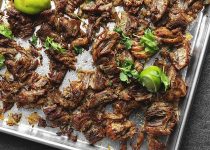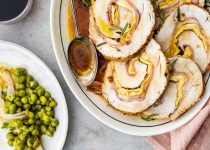A fava bean pesto and 10 ways to find inspiration again
Where has April gone? And what about March and February, that slipped away from my hands, silent, liquid, imperceptible. Not to speak of May: I’d swear it had begun just a few hours ago, yet I’m already planning activities for June. Only yesterday I was hoping to spend a few hours next to the wood burning stove reading a book, and today I find myself with a pile of books on the bedside table: there are memoirs, essays and novels, each one waiting in line for their turn to be read and enjoyed.
I used to prepare almost every evening a crisp fennel and blood orange salad with black olives, or a roast pumpkin to blend into a soup or a risotto, and now my kitchen explores all the shades of spring green, from broad beans to agretti and artichokes, which I now buy by the dozen.
I’m a walking cliché, wondering where my time has gone, munching on salted pistachios as I try to put my thoughts down in words. I thought that the arrival of spring could unblock something, that the new season could lift that boulder that stopped the flowing of words and ideas. But it didn’t work.
It is as if all the ideas I have inside – along with tentative projects, the recipes I would like to include in my book, the good intentions and the memories -, were so messy and unruly that they created one of those rush hour traffic jam that prevents even to the simplest thought of manifesting itself in a complete sentence.
I blamed some tiredness, the uncertain season, this spring that makes me crave a stew and a woollen jumper, even a certain seniority here on the blog, but in the end I realised that it was just a lack of focus.
So, during the first clear afternoon in a row of rainy days, I went for a walk.
When I walk by myself, I sit my problems in front of me and we have a chat. The problems turn into paths, into walked kilometres: the more I walk, the more I understand myself, we come to terms, and we reconcile.
It turned out that I have a longing for ten years ago, when everything was simpler, when everything began and ended in the pages of a blog: the stories, the recipes, but also the relationships.
At the same time, though, I want to see where the podcasts will bring us: I truly enjoy this feeling of being almost a pioneer in Italy, of tracing an unknown route: surely we will not be the first ones to launch a podcast, but we are the first Italians to have a podcast in English about our culinary traditions. That sense of unknown and trepidation that I experience every time we publish a new episode is adrenaline and motivation.
In this moment of precarious balance, I realised that to get back on track I need to focus on what I really love, I need pens and notebooks, as many as the ongoing projects. I feel the urge to make lists that make sense, with dates and deadlines, but also lists of thoughts and seemingly completely unrelated ideas.
When you feel stuck and have a writer’s block, when you lack inspiration, jot down lists: any list would do, they are just a way to get you started. I chose to write a list about everything that usually succeeds in rekindling my inspiration, about what in the past has been a source of encouragement, about what usually helps me to get in contact with creativity again.
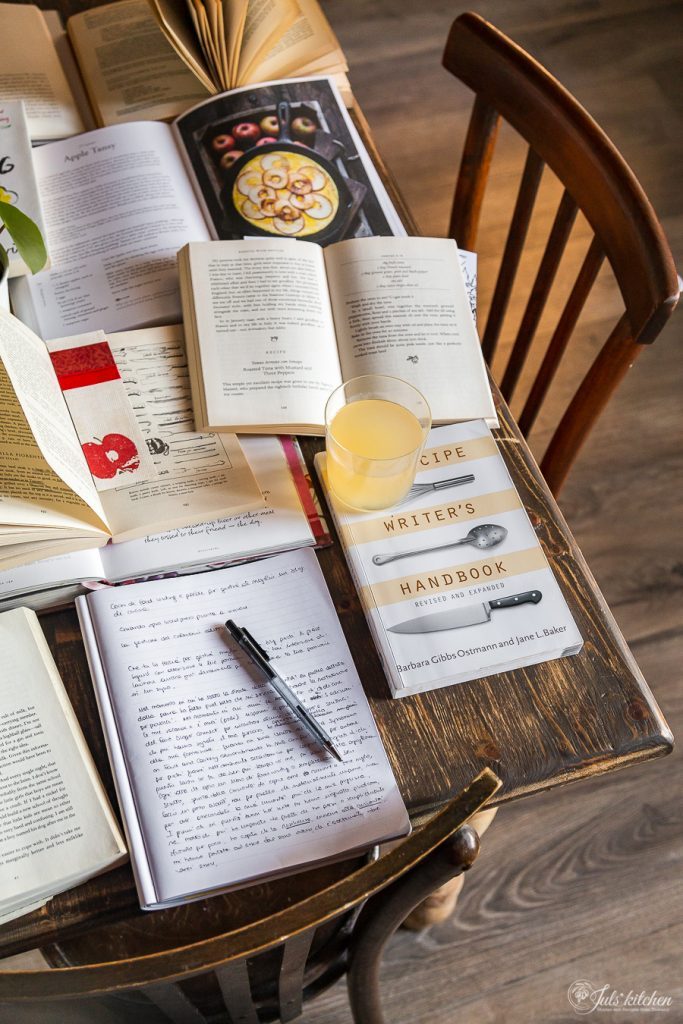
1. Surround myself with books
I could not start anywhere but here. I have the physical urge to surround myself with books, anchors to reality but also handholds for bigger dreams, which sooner or later will find space and time to develop. I keep these books on the bedside table, on the living room table, which I transformed into my desk, among rubber shavings and pistachio shells, into my computer bag, and over my smartphone, a clear message about the priorities I would love to have.
I read some of these books years ago, but once in a while I like to pick them from the shelf and stroke the marked pages, if only to experience again the same emotion, that sense of discovery and that inspiration that they had given me the first time I encountered these authors. From time to time I feel the need to re-read Elizabeth David and Laurie Colwin, to remind me of what I felt, because it was that moment of revelation, that thrill of recognition, that pushed me into the right path.
I’m not monogamous when it comes to books: next to the already read books, there are those that I’m reading now for the first time. There is a novel permeated by a sense of magical realism, to live other lives, and an essay on the role of time in the world of food and flavour, which is giving me countless insights.

2. Keep my hands busy
On Saturday morning I finally planted the aromatic herbs I had bought a few weeks ago and that, surprising myself, I had managed to keep alive into their pots, placed around the corner of the house, in between sun and shade. They neatly filled the new flowerbed that my father had made for me under the fig tree. I realised that I have to reduce my expectations, that before embarking on a vegetable garden that could feed a village, I’d better measure my strengths with challenges that are more in my reach.
Last year it was the turn of the flowerbed in front of our house, where I managed to keep alive, after the scorching heat of summer and the winter frosts, sage, pineapple sage, two raspberry plants, mint and lemon verbena. This year I double the stakes with a new aromatic garden, a harmonious and contained chaos, which will be a test and a daily challenge. I will slowly raise the bar, but I will do it only when I’ll be able to perfectly manage the previous level.
When I’m in the garden, or in my parents’ vegetable patch, I am completely immersed in my natural element, even if I never spend enough time there. This is why I need a daily ritual, like when in the evening during summer I drag around a heavy watering can to water my herbs. The relief that the herbs experience when they voraciously drink the water, releasing that smell of wet soil that reminds me of the wonder of the rainbow after the rain, is my relief. This happens when I keep my hands busy and allow my head to wander free.
Just like gardening, it works even with kneading bread by hand, trimming baby artichokes to preserve them in oil, cleaning the pantry and organising my flour jars in order not to leave anything behind.

3. Cooking just for pleasure
It might sound weird, but for me it is ever more difficult to find time to cook just for the sheer pleasure of it, even if everything began from there.
In between cooking classes, all the recipes developed and photographed for magazines and clients and the recipe testing for the blog, we live in a perennial state of overflowing leftovers. I freeze something, we have friends over for leftover dinners and we share food with my family, too. In our daily life, though, the question I usually ask Tommaso is: what do you want to eat? leftovers or a quick tuna salad?
So I started cooking again just for us, at least two or three times a week, just for the pleasure of sitting at the table in front of a meal designed and prepared especially for that moment. Although I am a great supporter of leftovers and believe in the creative recycle of what is left, a simple meal of fresh eggs cooked in tomatoes, the yolk so perfect and thick like honey, seems like a king’s meal when you’ve been eating reheated food for while.
With this ungodly cold spring, I cooked a stew again, simmering it on the stove for hours while I was working on new recipes. I kneaded a schiacciata time and again, trying to reach that perfect balance of softness, crispness and olive oil.
The biggest risk for those who have turned their greatest passion into their daily work is to lose sight of that primitive joy that gave way to everything. But if I close my eyes and smell the aroma of garlic sizzling in the hot olive oil, or when I rub fresh thyme in between my fingers, before adding it into a pan of potatoes, I feel exactly like when, more than ten years ago, I recognised in those smells the way home.
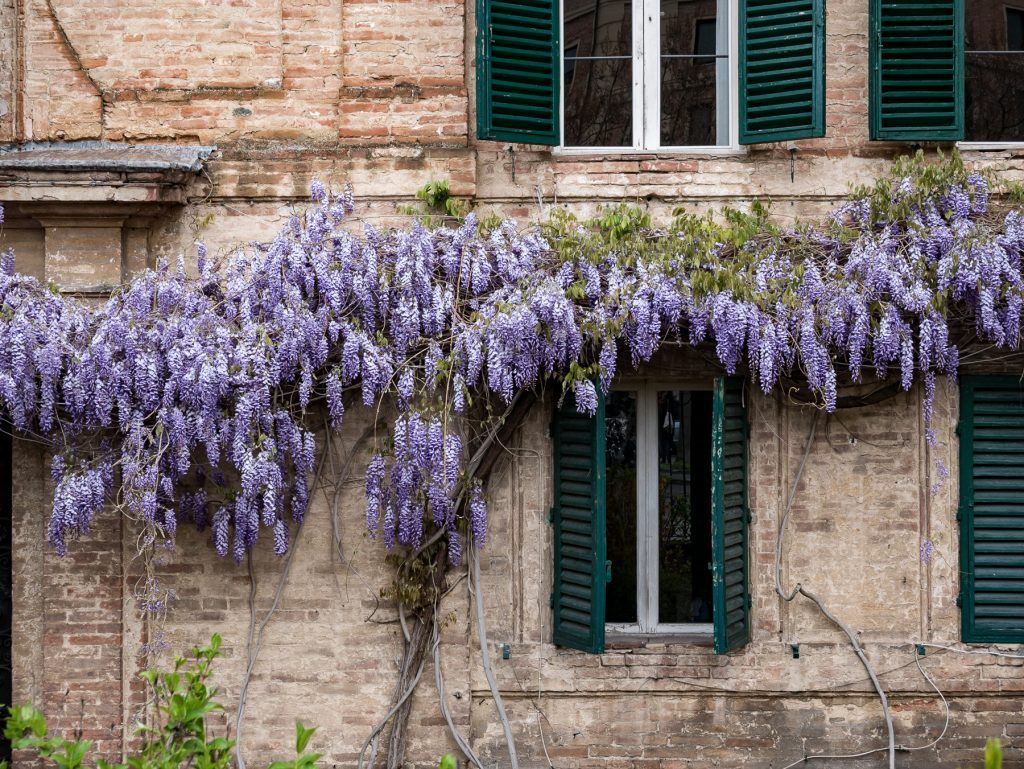
Then, in random order, I added to my list:
- studying: whether it is food writing, memoir writing, sourdough baking or foraging herbs, when I have a pen and a notebook in my hands to learn something new I always feel excited, as the first time I read Will write for food by Dianne Jacob;
- taking good care of me: for instance, I’d need a hand mask, as at the moment my hands are mercilessly showing the signs of time, of the innumerable dishes I washed, of the oven burns and of all the dough I kneaded by hand;
- walking: according to all the experts, physical exercise is one of the essential factors to feel good. Power walking is what works for me, possibly in the countryside, possibly late in the afternoon, with Noa, with fast, almost martial steps;
- French cooking magazines, which I just partially understand but which, as always, are as inspiring as the smell of butter on my hands;
- a change of air: if I could spend a week in London or Paris, I would leave immediately. But I noticed that smaller trips work as well, even a short drive to visit a friend in Val d’Orcia, or a day spent in a house without internet connection at the Mugello gates. A breath of fresh air helps you to rediscover yourself and to listen more carefully to your needs.
- opening all the windows in the house to let in the countryside air: I let in the smell of acacia flowers, as long as they last, then the smell of dry grass toasted by the sun, or the wonderful smell of summer rain;
- finding time to read blogs again, or listen to new podcasts, to discover new trends, new perspectives, or savour the comfort of a well-written recipe.
Ten years have passed since I started this blog
It is the longest relationship I’ve ever had. There have been moments of struggle, of time off, of tiredness, and certainly there will be more. It is normal. What I hope, though, is to always find a reason to go on, to maintain – or should I say to alway remember – the same enthusiasm of the first months, that excitement that I felt every time I discovered a new ingredient: the first time I shelled fresh peas, the first time I bought a thyme seedling and rubbed it in between my fingers, or that time I had my very first taste of passion fruit. Today they might seem trivial moments, but in these ten years they helped me to understand myself better and figure out who I wanted to become. They have taught me the meaning of commitment and dedication.
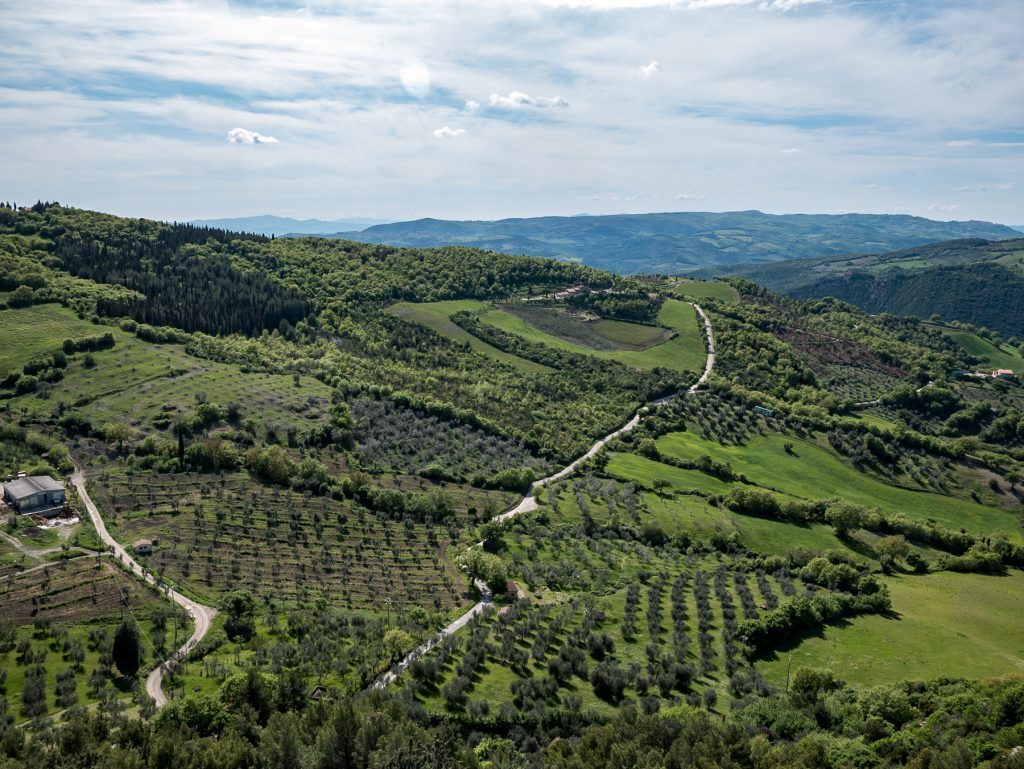
So what did we do in the past month?
We worked on different projects, I taught several cooking classes, we celebrated Easter with the family. I baked sourdough bread and a few kilos of pizza in our wood-fired oven. I practiced my schiacciata recipe, I walked when the rain granted me a clear afternoon. I read before sleeping, though sometimes I fell asleep as soon as I rested my head on the pillow. I have jotted down for the umpteenth time the idea for the next book, and maybe, maybe, this will be the right one. I wrote for Dievole and for The Epoch Times, I took photos and developed recipes for Ci Piace Cucinare and Casa in Fiore. We tried to plan our activities for the next few months, and we had to rethink our priorities once again.
We took three days off to be tourists in Tuscany: we went to Monte Amiata and Val d’Orcia, to visit Luisa, we went to Paugnano to buy some cheese and then to Siena. By the way, did you know that Tommaso and I have written a food guide on Siena for Travel With Gusto? For the moment it is just in Italian, but in a month it will be published in English as well. It’s an eBook, and you’ll be able to buy it on Amazon and other online bookstores.
On the blog everything was calm and silent, even on social media we had a little break. We are late with the new episodes of our podcast, and the newsletter has been missing from your mailbox for quite a while, but now – slowly – we will catch up with everything.
Where to start again? But of course from here, from the blog. And we begin with a spring recipe, a fava bean pesto to dress a seasonal bowl of pasta.
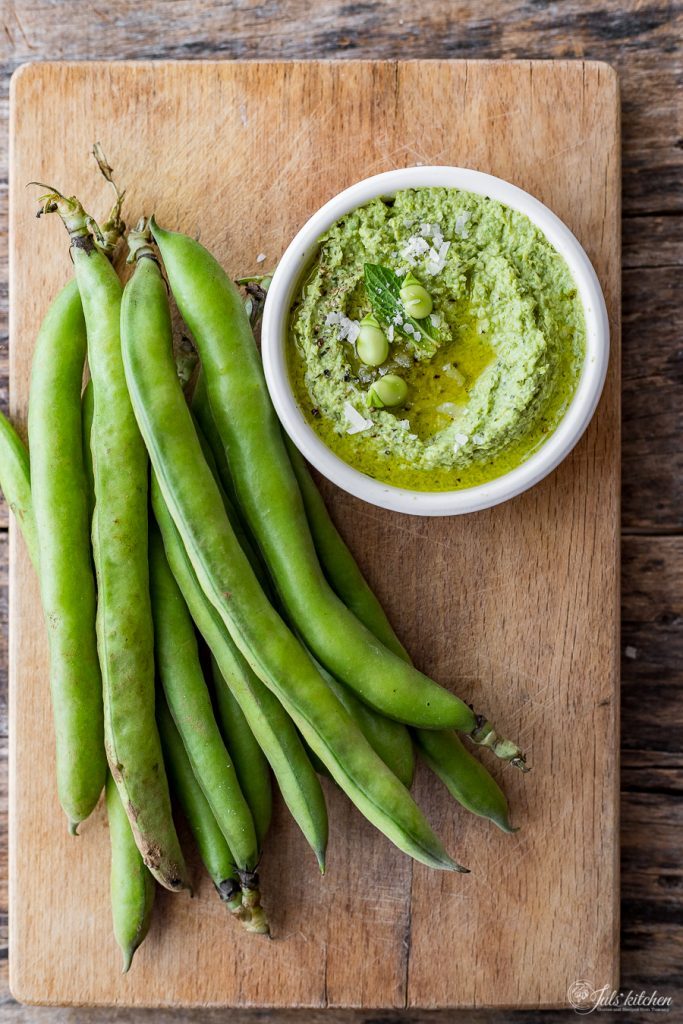
Pasta with a fresh herb and fava bean pesto
How many times do I buy whole bags of fava beans at the market, with the idea of eating them with fresh pecorino, and then I forget about them? More than I would like to admit. This is when I make pesto: shelled fava beans, a bunch of fresh herbs, extra virgin olive oil and at the end some grated aged pecorino. It is a spring pesto, which first requires some patience and meditation in shelling the beans, but then you can make it while you cook the pasta. It has all the fragrance and taste of a seasonal picnic, even when it is raining outside.
Pasta with a fresh herb and fava bean pesto
It is a spring pesto, which first requires some patience and meditation in shelling the beans, but then you can make it while you cook the pasta. It has all the fragrance and taste of a seasonal picnic, even when it is raining outside. CourseFirst course CuisineItalian Keywordpecorino, pesto, fava beans, broad beans, fresh herbs Prep Time10 minutes Cook Time10 minutes Total Time20 minutes Servings people
Ingredients
- 1,5 kg (3.31 lb) of fava beans, about 300 g (10 oz) once shelled
- 10 fresh basil leaves
- 10 fresh mint leaves
- a few sprigs of fresh thyme
- 60 ml (4 tbsp) of extra virgin olive oil
- 100 g (3.53 oz) of aged Tuscan pecorino
- a few rounds of black pepper
- 400 g (3/4 lb) of short pasta, in my case whole wheat mezze maniche
Instructions
- Shell the fava beans and collect them in a blender glass. Add the fresh herbs and the olive oil.
- Blend for a few seconds at a time, so as not to overheat the olive oil, until you get a fairly smooth and pesto. I like to leave some texture, so I stop before it becomes too smooth, when it’s still quite rustic.
- Transfer the pesto into a bowl and add the grated pecorino cheese. Mix well, add a little more olive oil if needed, and season with salt and pepper. Taste until you find the perfect balance.
- Scoop the pesto in a jar and cover it with olive oil. You can keep it in the fridge for a few days.
- When you want to use the fava bean pesto, cook the pasta in plenty of boiling salted water. Drain the pasta al dente and reserve half a glass of water to dilute the pesto.
- Pour the pesto into a bowl and add a few tablespoons of hot water, then stir well to soften the pesto. Pour the pasta into the bowl, toss it and serve with a sprinkling of grated pecorino.

